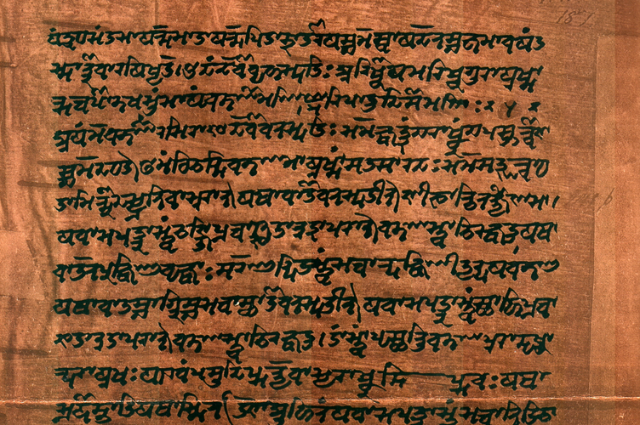
The four Vedas
The Vedas are often compiled into a single book, the chaturveda, Samhitha, which contains four separate sacred texts.
- The Rig Veda, the book of mantras
- The Sama Veda, the book of song
- The Yajur Veda, the book of rituals
- The Atharvana Veda, the book of spells
The Vedas may be considered as knowledge texts, and generally speaking, there is a strong priestly bias to them, as the Brahmins monopolised the production and the transmission of these texts. The Atharva Veda itself has been translated to mean the Veda of the magic formulas. Though not all scholars agree with this translation, nevertheless, compared to the other three Vedas, the Atharva Veda seems to represent popular religion as its charms and incantations are more folkloric in nature.
Among the four Vedas, the Rig Veda is the oldest one, which is about a collection of ten books, also known as mandalas. While they are composed to praise the gods, they also address historical events such as the struggle between the aryans, the early Vedic people, and the Dasa.
About Atharvana Veda
Legend has it that two groups of rishis, the atharavana and the angirasa, composed the Atharva Veda. In fact, that is where its oldest name, Atharvangirasa, comes from.
It is believed that the Rishis achieved eternal knowledge and supreme bliss after a deep and committed meditation. After becoming enlightened, they composed their newfound sacred knowledge into hymns. Another version, which was written by Atharva, another legend has it that he was the son of Vasishtam, and the son of Brahma.
The Atharvana Veda is one of the four sacred texts of Hinduism, and it’s named after a group of priests called the Atharvan. Just like the other three Vedas, it’s a source of knowledge and insight into the ancient Indian way of life as well as the history and evolution of Hinduism. What’s different about the Atharva Veda is that its content is more diverse. It includes spells and incantations for healing and protection, hymns for weddings and other ceremonies, and philosophical and ethical teachings.
The Atharvana Veda may be an ancient text, but its timeless wisdom is as relevant today as it was thousands of years ago. So whether you’re seeking spiritual guidance, healing solutions, or just some good old-fashioned spells to ward off evil spirits, this particular Veda has it all. Known as the language of the gods, the Vedas are believed to have been channeled by sages. And whoever aspires to comprehend them, the Atharvana Veda included, can access their divine wisdom.
The Atharva Veda is divided into 20 kandas, which contain a total of 730 suktas. In total, the Atharva Veda has about 6000 mantras, most of which are metrical. It may be noted, however, that a small number of hymns, estimated to be about a sixth of the entire Atharvana Veda, were written in prose.
The natures of Atharvana mantras
The Atharvana mantra has been described as the Veda of varied knowledge, as it deals with numerous subject matters. These may be divided into three main categories. The first of these related to the curing of diseases and the destruction of adverse forces.
Some charms were meant to combat spiritual rather than physical illness. These include charms against possession by demons of disease, and charms meant to protect a person against malicious adversaries, such as sorcerers and enemies thwarting holy work.
The second category consists of hymns related to everyday life, such as health, wealth, friendship, and marriage. Examples of hymns that fall in this category include charms for a woman to obtain a husband, a charm to promote virtue, a charm to deprive a man of his, and a charm to secure perfect health.
The third category of hymns pertains to higher matters, such as the nature of the supreme being, immortality, and time. Examples include the hymn to goddess Earth and the glorification of the sun, or the primeval principle as a Brahma disciple.
About 20 percent of this text is found to overlap with the Rig Veda. Nevertheless, the rest of the verses are unique to this book and provide a representation of the concerns that the common man during this Vedic period had in his day-to-day life. Thus, the Atharva Veda has been considered to be a representation of popular religion, as opposed to the hieratic religion as seen in the other three Vedas, and it is in this respect that the Atharva Veda may be considered to be an important source of information for an understanding of the Vedic period.
Popular mantras from Atharvana Veda
Gayathri mantra, which we chant every day, is referred to as Atharvana mantra. Om bhur Bhuvan shah, tat Savitur varenyan Bhargo devasya dheemahi, dhiyo yo nah prachodayat.
Meaning: we meditate upon the supreme effulgence of the divine sun, who illuminates the three worlds. May that divine light guide our intellect and inspire our thoughts.”
Om Asato maa, sadgamaya, tamaso maa jyothirgamaya, mritoyormaa Amritham gamaya.
Meaning: lead us from untruth to truth, from darkness to light, and from morality to immorality.
Athravana stands as a profound testament to the wisdom and knowledge of the ancient seers. Its teachings continue to resonate in the modern era, offering valuable insights into various aspects of life. Atharvana Veda encompasses a broad spectrum of subjects, ranging from spiritual enlightenment to physical well-being, making it a comprehensive guide for a balanced and harmonious existence. The hymns mentioned above are just a glimpse of the profound wisdom encapsulated within Atharvana Veda.
The true power of Atharvana Veda lies not only in reciting its mantras but also in embodying the virtues they represent, thereby creating a positive impact on ourselves and the world around us.
References
- superprof.co.in
- vedicheritage.gov.in
